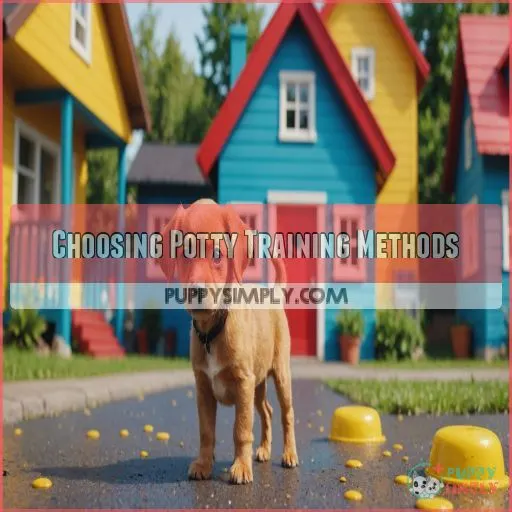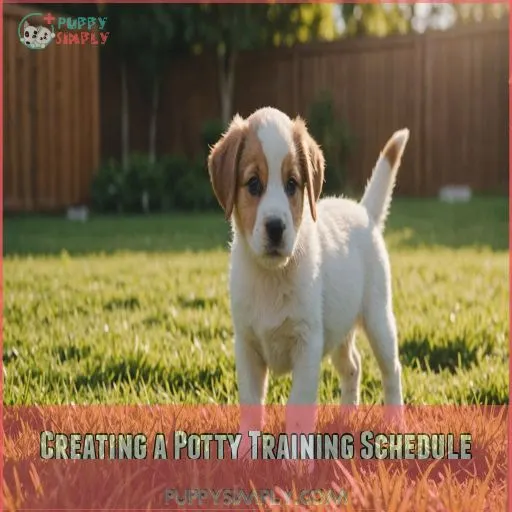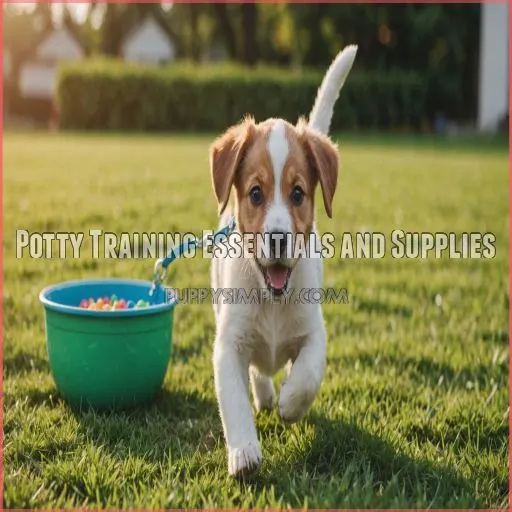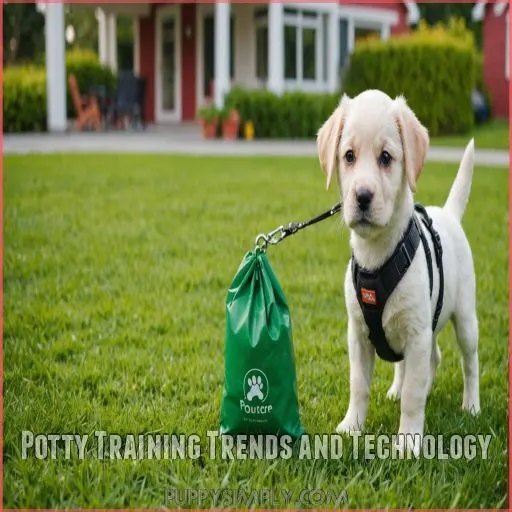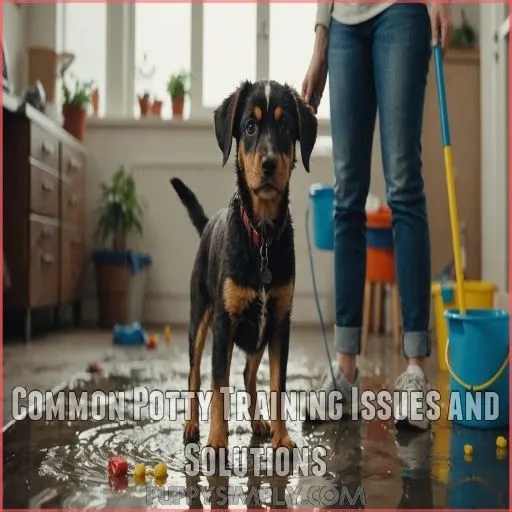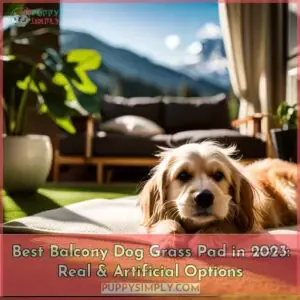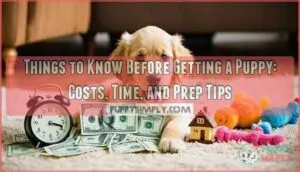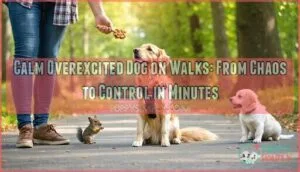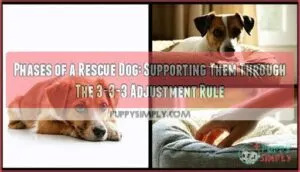This site is supported by our readers. We may earn a commission, at no cost to you, if you purchase through links.
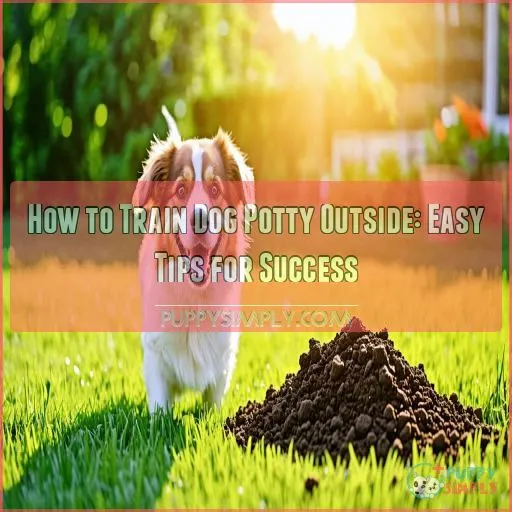
Pick a consistent potty spot and take them there after meals, naps, and playtime. Stick to a schedule – morning, after meals, and before bed.
Reward with treats when they go in the right place. It takes patience, but your pup will get the hang of it. Soon, you’ll have a well-trained dog who knows where to do their business.
It takes a well-trained dog to know where to do their business. Just wait until you see how proud they’ll be when they nail it, and it will make you proud of their well-trained habits and the fact that they now know where to do their business with potty training.
Table Of Contents
- Key Takeaways
- Choosing Potty Training Methods
- Creating a Potty Training Schedule
- Potty Training Essentials and Supplies
- Overcoming Potty Training Challenges
- Potty Training Trends and Technology
- Common Potty Training Issues and Solutions
- Tips for Successful Potty Training
- Frequently Asked Questions (FAQs)
- How do you train a puppy to potty outside?
- How do you teach a dog to potty?
- Can Dogs Go potty outside?
- What are the best methods for potty training a dog?
- Can an 8-week old puppy be potty trained?
- What is the easiest way to potty train a puppy?
- How do you train a puppy to pee and poop outside?
- How long does it take to potty train a dog outside?
- How to train your dog to go potty outside?
- How to train your dog to poop in one spot in the yard?
- How do you train a dog from peeing and pooping in the house?
- What age should potty training begin?
- How do I train a rescue dog?
- Can any breed be potty trained outside?
- How long does potty training usually take?
- What if my dog refuses to go outside?
- Conclusion
Key Takeaways
- Keep an eye on signs like circling or sniffing to know when your dog needs to go outside. Set up a consistent routine after meals, naps, and playtime, and use a keyword like "go potty" to help them associate the action with the command.
- Opt for potty bell training as a fun communication tool. Hang a bell at your dog’s nose height and reward them every time they ring it, making trips outside clear and easy.
- Weather challenges, such as rain, can make potty training tricky. Invest in waterproof gear or consider an indoor potty system for rainy days. Make it fun – picture singing in the rain together, minus the puddles!
- Accidents are bound to happen, so remain patient and maintain a positive attitude. Reward every successful outdoor venture with treats and praise. Remember, consistency is your best friend in this journey – you’ve got this!
Choosing Potty Training Methods
In terms of helping your dog learn where and when to go potty, choosing the right method can make all the difference.
From potty bells that keep your dog in sync with your routine to training on cue for more efficient breaks, you’ll find a method that turns those potty trips into a smooth experience.
Potty Bell Training for Effective Communication
Looking for effective dog training? Potty bell training is your ticket to clear communication! Teach your pup to ring a bell, making house training a breeze.
- Setup the bell at your dog’s nose height.
- Reward with treats each time they ring it.
- Stay consistent, and watch them master this skill.
It’s barking up the right tree for success!
Potty Timing for Consistency and Success
Imagine this: your pup, with a look that says, "I gotta go!"
Understanding potty timing cues is your secret weapon. Stick to an ideal potty break frequency; for puppies, that’s every hour or two, while older dogs may last longer.
Keep a sharp eye for signs of needing to go and you’ll master dog potty timing in no time!
Potty Training on Cue for Efficient Potty Breaks
One effective way to potty train your pup is by using cue words, especially with Bichon Frise training
. Whenever you take them outside, say a specific phrase like "go potty" . This verbal cue will help your dog associate the action with the command.
Pair it with clicker training or treats to reinforce the behavior.
Consistent timing and positive reinforcement are key for efficient potty breaks.
Establishing a Potty Training Routine for Dogs
Kick off your potty training routine by sticking to a consistent schedule for puppy potty breaks, using a puppy bathroom routine
. This prevents accidents and helps your dog learn.
Adjust the schedule as needed, considering routine changes like meals or playtime.
Remember, dog distractions are real! Stay vigilant and patient, and keep things positive and fun.
Before you know it, accidents will be yesterday’s news!
Creating a Potty Training Schedule
Creating a potty training schedule is your secret weapon for getting your dog to potty outside consistently.
Think of it as a daily routine that sets both you and your pup up for success, like knowing when to expect commercials during your favorite show.
Morning Potty Breaks for a Fresh Start
You’ve chosen a great dog training method to teach your dog to sit
!
Now, focus on morning routines for a fresh start.
Consistency tips? Make early morning walks a non-negotiable in your schedule.
Avoid accidents by setting your clock to potty o’clock!
Starting your day with dog training advice helps prevent accidents and strengthens the bond and joy of pet training.
After Meal Potty Breaks for Timely Relief
How do you keep accidents at bay after meals?
Create a potty schedule! Puppies need to go shortly after eating since meal timing impacts digestion.
Make sure your furry friend gets outside 5-30 minutes post-meal to prevent messes indoors.
Think of it as their daily post-meal walk, not just a bathroom break—your carpet will thank you! .
Before Bedtime Potty Breaks for a Peaceful Night
Feeding your dog after meals is a timely relief, but don’t forget about those nighttime potty routines.
Take your pup out for a last pee break just before bed.
It avoids nighttime accidents and supports a peaceful sleep. This simple trick in dog training can improve sleep schedules, making you both happier night owls .
Regular Interval Potty Breaks for Consistency
After ensuring a peaceful night, focus on creating a schedule for regular potty breaks to keep consistency in training. Dogs thrive on structure, so setting an ideal interval for breaks makes life smoother.
Here’s a simple approach:
- Every few hours: frequent potty breaks.
- Right after meals: avoid accidents.
- After playtime: always a good idea.
- Use potty cues: enhance understanding.
Potty Training Essentials and Supplies
Potty training your pup doesn’t have to be a headache.
Grab the right supplies like pee pads, carpet cleaners, and a cozy crate, and you’ll be on your way to a clean, happy home in no time.
Pee Pads for Temporary Use and Training
Got a potty schedule down pat? Let’s chat pee pads. They’re like training wheels for your pup—a temporary helper.
Experiment with different sizes, placements, and cleanup to fit your lifestyle. And don’t forget to gradually wean your pup off them.
Consider these:
| Feature | Consideration |
|---|---|
| Pee Pad Size | Fits your space |
| Pee Pad Placement | Easy access |
| Pee Pad Weaning | Gradual process |
| Cleanup | Quick and easy |
Carpet Cleaners for Accidents and Stains
Imagine this: your furry friend skips pee pads and chooses your carpet instead. Don’t fret!
Grab a pet-safe carpet cleaner like Nature’s Miracle or Simple Solution (Source). These brands work wonders on stains while calming dog anxieties with natural scents.
For the DIY enthusiast, vinegar and baking soda make a great team for tackling those pesky accidents with a great team .
Baby Gates for Restricting Access and Safety
While carpet cleaners tackle accidents, baby gates secure the field. By establishing a consistent schedule and aligning the puppy’s feeding schedule, nap time, play time, and walks, you can better anticipate when they need to go potty and place gates accordingly Potty Training Basics. Embracing these gate duties as part of a Shetland Sheepdog puppy routine is key to successful potty training
.
- Barrier Options: Explore different baby gate types for your space.
- Strategic Spots: Make sure gate placement blocks off risky zones, reducing the likelihood of accidents.
- Safety Checks: Regularly examine for potential safety concerns.
- Training Time: Familiarize your pup with gate training for rewarding dog safety and welfare.
Laugh at mishaps, but prioritize safety!
Kennel or Crate for Training and Housebreaking
Let’s face it, using a dog crate feels like giving Fido his own little studio apartment.
Crate training benefits are immense: from housebreaking to reducing crate anxiety.
Keep it cozy yet snug with a proper crate size guide.
Stick to a crate training schedule, ensuring it’s more of a safe haven than a jail cell.
Voilà, happy dog potty breaks!
Overcoming Potty Training Challenges
Potty training your dog can feel like a battle of wills, especially when they find every little distraction more interesting than doing their business.
But hang in there— patience, consistency, and a few tricks up your sleeve will get you through the struggles, such as using a routine and rewards to encourage good behavior and minimize accidents, which can be frustrating for both you and your dog.
Addressing Accidents and Consistent Training
Inevitably, accidents will happen, and when they do, keep calm and follow a clean-up routine. Laugh it off—consider it a bonding experience.
Positive reinforcement is key; reward your pooch every time they do their business outdoors. Consistent training builds mastery over time, so don’t lose hope if success seems elusive.
Additionally, crate training techniques can be a lifesaver in preventing accidents, giving you peace of mind when you’re not supervising. Patient persistence is your best friend in this journey.
Occasionally, consult a dog veterinarian if issues persist—there might be underlying health concerns. Don’t forget, weather impacts your dog’s potty habits too! (Source)
Distractions During Potty Breaks and Minimizing Interruptions
Don’t let distractions derail your dog’s potty training. When taking your pup outside, avoid busy streets, loud noises, and tempting dog parks – they’ll only distract from the task at hand.
Keep your dog on a short leash and ignore any attempts to play or explore. Stay focused, walk back and forth, and reward your dog the instant they go potty in the right spot.
With patience and consistency, you’ll have your furry friend house-trained in no time.
Potty Training Trends and Technology
Who knew that potty training could get a tech upgrade?
From indoor potty systems to electronic training gadgets, there’s no shortage of tools to make your dog a pro at going outside.
Indoor Potty Systems for Convenient Relief
Sometimes accidents happen, but with indoor potty systems, you’re giving your dog a convenient backup plan.
From grass patches to self-cleaning pads, the types of systems are as varied as dog personalities.
Consider the pros and cons: automated cleanup equals less odor, but initial setup may require patience.
Regular cleaning routines make sure a fresh environment is maintained with automated cleanup and regular cleaning routines, as a fresh environment.
Electronic Training Devices for Efficient Potty Training
Stepping outside just got tech-savvy. Electronic training devices make potty training feel like a breeze, especially for dogs that struggle with separation anxiety when you’re not around.
They can even be a helpful tool for recognizing separation anxiety. With options like e-collars, you can choose stimuli that best suit your dog’s learning style.
They’re effective and safe when used with care, helping you master potty training efficiently. User reviews highlight their success stories, making these gadgets a worthy consideration.
Positive Reinforcement Techniques for Effective Training
Training your pup with positive reinforcement is like teaching them with love.
Use clicker training to mark good behavior instantly. Set up reward schedules, and keep treat choices exciting yet healthy.
Timing rewards is key—catch them in the act!
Understand motivation levels: some pups might work harder for a tasty treat or a squeaky toy, based on their individual motivation levels.
Common Potty Training Issues and Solutions
Don’t sweat it if your dog has accidents or hesitates during outdoor potty breaks; you’re definitely not alone. You’ve got this—check out these simple fixes for common potty-training hiccups.
Health Issues Affecting Potty Training Success
While exploring the latest potty training gadgets, remember health issues like urinary tract infections or kidney disease can throw a wrench in your plans.
If Fido’s having accidents, it might be gastrointestinal issues or even mobility limitations.
Medications can mess with potty habits too. Always consult your vet—nobody wants a piddling pup on prescription side effects.
Inconsistent Training and Establishing a Routine
Inconsistent training can derail your dog’s potty progress.
Establish a routine – take them out at the same times daily and reward successes. Don’t get discouraged by setbacks; every dog has a unique personality.
Stick with it, and you’ll soon have a house-trained pup. Consistency and patience are key to potty training triumph.
Environmental Factors Like Rain and Alternative Solutions
Rain doesn’t have to rain on your potty training parade! Invest in some waterproof gear and create handy shelter solutions like awnings for rainy-day potty options.
Consider an indoor potty system for those torrential days.
When life gives you puddles, grab an umbrella and make it fun—they’ll soon master potty time, rain or shine!
Tips for Successful Potty Training
Training your dog to potty outside can feel like a juggling act, but with the right tips, you’ll both be doing a happy dance on the lawn.
From treating successful outings to embracing new sights and sounds, here’s how to make the process smoother and more rewarding.
Encouraging Positive Interactions With Other Dogs and People
Addressing potty training challenges can feel like taming a hurricane. Encourage positive interactions to boost confidence.
Dog park etiquette and leash manners matter; remember, first impressions count!
- Puppy playdates are goldmines of social cues.
- Safe greetings prevent sticky situations.
- Embrace diverse surroundings to reinforce good behavior.
Master these tips, and your pup will shine bright!
Socialization Classes for Potty Training Success
Embracing the chaos of puppyhood? Try socialization classes! They’re golden for potty training success.
These classes benefit from group dynamics; your pup learns faster alongside others.
Class benefits include practical socialization tips while offering hilarious success stories to share.
Your pup will master not just the potty but the joys of play with peers, too, which is crucial for potty training success. (Source)
Exposing Dogs to Various Sights, Sounds, and Smells
Socialization classes set the foundation.
Now, expose your dog to various sights, sounds, and smells. Take city walks, explore dog parks, and visit new places.
Let traffic sounds and familiar smells become their comfort zone.
Imagine the city as your dog’s playground—each experience, like seasoning on a steak, adds flavor to their world and aids in successful potty training.
Rewarding Desired Behaviors With Treats and Praise
When your pup toilets outside, reward them with treats and praise right on the dot—timing’s everything!
Balancing treats versus praise keeps motivation high without turning your dog into cookie monster.
Use positive reinforcement consistently, and watch those desired behaviors stick like glue.
With a mix of affection and well-timed rewards, you’ll master potty training in no time!
Frequently Asked Questions (FAQs)
How do you train a puppy to potty outside?
Start by taking your puppy outside often, especially after meals and naps.
Use a specific phrase to signal potty time.
Always reward them immediately after they go.
With patience, their routine will become second nature.
How do you teach a dog to potty?
Did you know puppies need to potty every two hours?
Establish a routine by taking your dog outside regularly, especially after meals and naps.
Reward them with treats and praise to reinforce good behavior.
Can Dogs Go potty outside?
Absolutely, dogs can go potty outside.
It’s all about consistency and patience. Create a routine, use rewarding words, and shower them with praise or treats when they succeed.
Your backyard will become their outdoor bathroom, with the use of rewarding words.
What are the best methods for potty training a dog?
Potty training a dog requires consistency, patience, and positive reinforcement.
Take them to the same spot each time, praise them when successful, and keep a routine.
Use a crate as a helpful tool to prevent accidents.
Can an 8-week old puppy be potty trained?
You can indeed potty train an 8-week-old puppy with patience and consistency.
Start as soon as they come home, taking them out frequently and using positive reinforcement to create good habits early on.
What is the easiest way to potty train a puppy?
Consistency is key when potty training a pup.
Stick to a schedule, reward good behavior, and clean up accidents thoroughly.
With patience and positive reinforcement, you’ll have your furry friend house-trained in no time.
How do you train a puppy to pee and poop outside?
Imagine calm mornings without indoor messes.
Guide your puppy to a chosen outdoor spot, use a cue like "go potty," and reward them every time they succeed.
Patience and praise are key to mastering this routine.
How long does it take to potty train a dog outside?
Potty training a dog often takes 4-6 months, but some may need up to a year.
Patience and consistency are key.
Watch for signals, reward successes, and keep the process positive.
It’s all about practice .
How to train your dog to go potty outside?
Picture taking your dog to their special spot outside, leash in hand.
Use a keyword like "potty" as they go. Reward immediately after with treats or praise to reinforce their behavior.
Consistency and patience are key.
How to train your dog to poop in one spot in the yard?
Choose a spot and keep poop there to set the smell.
Guide your dog on a leash to that area after meals, rewarding with treats when they succeed.
Their nose will remind them where to go.
How do you train a dog from peeing and pooping in the house?
Rome wasn’t built in a day, and neither is house training a dog.
Watch for cues like sniffing, take them out promptly, and reward with treats and praise instantly for going outside.
Consistency is your best friend.
What age should potty training begin?
Start potty training your puppy as soon as you bring them home; aim between 8 to 16 weeks old.
Remember, patience and positive reinforcement are key.
Every pup learns differently, but with consistency, you’ll see progress!
How do I train a rescue dog?
Did you know that over 3 million dogs are adopted from shelters each year?
When training your new rescue pup, start with the basics – sit, stay, come – and use positive reinforcement to build their confidence.
Take it slow and they’ll be a pro in no time!
Can any breed be potty trained outside?
Absolutely, any dog breed can be potty trained outside.
The key lies in consistency, patience, and rewarding good behavior immediately.
Even small breeds, often seen as trickier, can master it with the right techniques.
How long does potty training usually take?
Potty training your pup isn’t a sprint, it’s a marathon.
Most take 4-6 months to get accident-free, but some need a full year.
Patience, praise, and consistency are your best friends in this journey.
What if my dog refuses to go outside?
If your dog refuses to go outside, consider checking for health issues or fear triggers while ensuring positive outdoor experiences.
Sometimes, a little patience and a few tasty treats can turn the tide in your favor.
Conclusion
Think of training your dog to potty outside as planting a garden; with time and care, you’ll see remarkable growth.
Stick to a schedule, reward successful outings, and handle setbacks with patience.
Your dog’s resilience and ability to learn will impress you and also create a stress-free environment around potty time.
By following these tips, you’ll master the art of how to train dog potty outside, cultivating a well-mannered furry friend.

